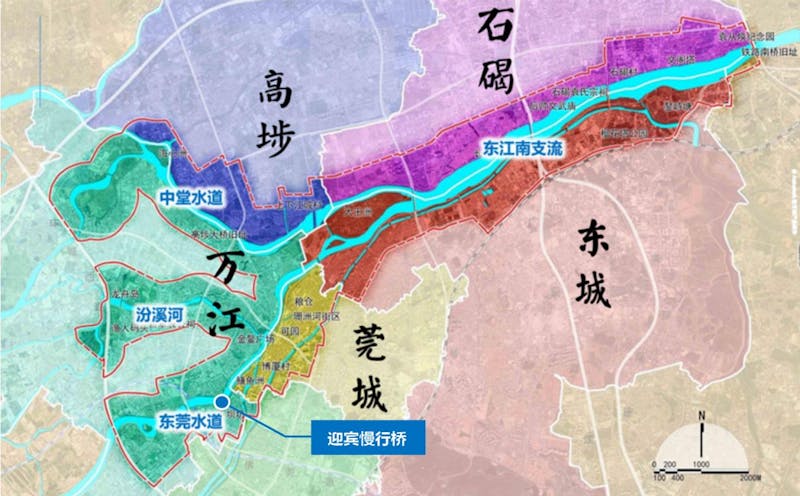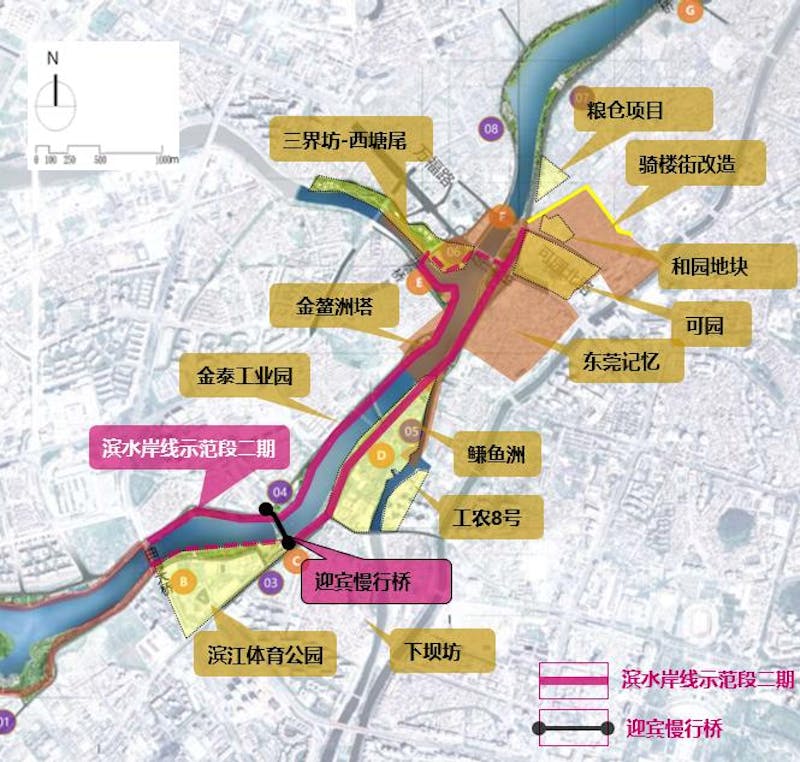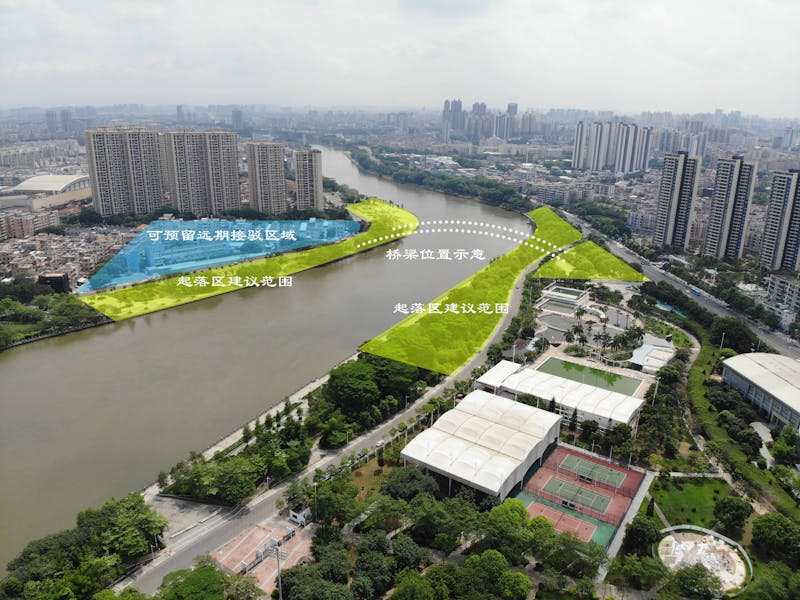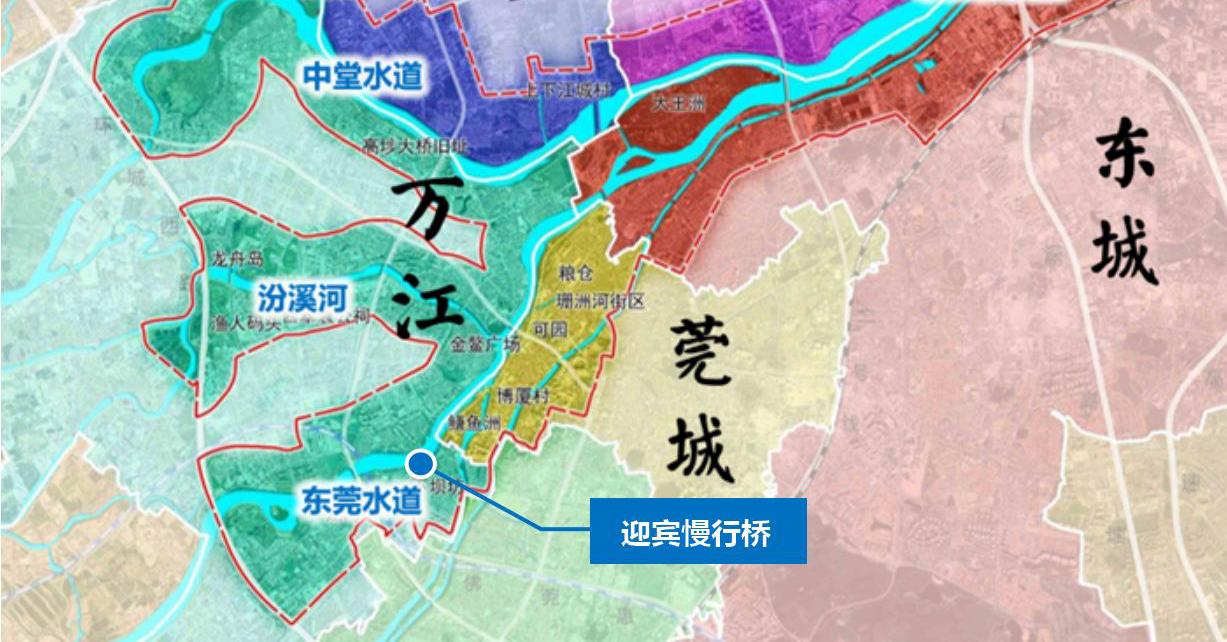Summary: This international consultation aims to invite well-known design teams at home and abroad to carry out the international brainstorming for the conceptual design of Yingbin Pedestrian Bridge in the waterside area with an international vision, forward-looking thinking and innovative outcome.
Description:
Announcement of the International Consultation on the Conceptual Design of Yingbin Pedestrian Bridge in the Riverside Area
PROJECT OVERVIEW
1. Project Background
Since early 2019, Dongguan Municipal Government has comprehensively promoted the planning and construction of “One Core, Two Axes, Three Areas” in the central city with an aim to build a demonstrative benchmark of “thriving Dongguan, a pearl in the Greater Bay Area”, and established the development blueprint of “halving Dongguan in mountains and waters, a wonderland in the vein of three rivers” centering on the strategy of “Landscape City”. Among other things, the riverside area, as the main carrying space of the “water” strategy of central urban area in Dongguan, is the bridgehead of the connection between the central urban area and the waterside, and plays a big role in the citywide development in terms of historical and cultural inheritance, the mining of its waterfront ecological value, and the shaping of its livable living environment. It is the section with the most abundant coastal water resources, the most mature development conditions, the largest potential for stock renewal and the most essential historical characteristics in the Dongjiang River basin. It is also the area sprawling in the most extensive domain, involving most towns and streets and facing the most complex situation in the strengthening of the central city. The Construction Headquarters of Dongguan Central Area, adhering to the working concept of “clustering, city-town co-building and city operation”, and taking “systematic planning and high-standard construction” as its working goal, in a high-level and all-round way, promotes the construction of waterfronts in the riverside area, as well as the construction of public cultural products, historical and cultural activation and utilization, transportation infrastructure construction, land development and utilization, and more.
With the long-term development practice, there are still some problems to be solved with the riverside area, such as transportation, which, due to large spacing between cross-river bridges and all are bridges for vehicular circulation, leads to cross-river traffic block, certain isolation of functional connection, traffic organization, cross-coast interaction of waterfronts and connection of cross-coast backlands, and poor pedestrian accessibility, all of which have major impact on functional layout, traffic connection, livable quality in the area.
The action initiative for building four cross-river pedestrian bridges is respectively proposed in the Conceptual Design of Waterfront Demonstration Section of the Waterside Area, the Comprehensive Transport Planning on the Riverside Area and the Special Research on the Control of Urban Space Forms and Urban Design of Waterfront Demonstration Section in the Riverside Area, in order to effectively enhance the seamlessness of traffic functionality and accessibility through the construction of these cross-river pedestrian bridges in waterfronts in the riverside area, improve the slow traffic system of the areas, strengthen the slow traffic accessibility on both coasts along the riverside, drive the high-quality construction of the backlands, and form a strong attraction, so as to promote the city image and comprehensive competitiveness of Dongguan.
Based on this context, the Construction Headquarters of Dongguan Central Area clearly proposed the related work requirements of commencing the construction of the first cross-river pedestrian bridge at the 4th Work Meeting. This international consultation on the conceptual design of the first cross-river pedestrian bridge (Provisionally named “Yingbin Pedestrian Bridge”) in the riverside area is initiated by the Construction Headquarters of Dongguan Central Area, the Organizer, with a view to promote the high-level planning and construction in the riverside area, help build high-quality urban environment and city image of the historical and cultural recreational resorts there, establish the brand of charming waterfront city, and participate in the competition and cooperation in the Greater Bay Area as a waterfront city.
2. Project Location
The riverside area is located in the northwest of the central area of Dongguan City, where it is a main urban waterfront space relying on the southern tributary of Dongjiang River and its three branches and three water systems of Zhongtang Waterway, Fenxi River, and Dongguan Waterway. Along these three water channels it starts from Guangzhou-Kowloon Railway in the east, and ends on the west ring road, covering the key urban functional nodes, waterfront open spaces and the areas to be constructed in short term along the waterfront. The total planning area is 48.7 square kilometers, involving five towns and sub-districts (Guancheng, Dongcheng, Wanjiang, Gaobu and Shijie), including a total length of about 35 kilometers with the three water systems, and the shoreline of about 70 kilometers.
The demonstration section in the waterside area refers to the section between Lichuan Bridge and Oversize Bridge over the Dongguan Waterway, with the span of about 17km, where it is bestowed with the best geographical condition, most mature development foundation, and the most concentrated historical and cultural resources in the waterside area, having potentials and conditions for early pilot, recent boom and construction of a demonstration and essence section. So far, the first phase of the waterfront demonstration section has been officially opened on May 1, 2021, with good feedback and high recognition from the public.
Yingbin Pedestrian Bridge is intended to be located in the scope of the second phase construction of the waterfront demonstration section. It is a sightseeing pedestrian bridge connecting both waterfronts across Dongguan Waterway, and also the first cross-river sightseeing pedestrian bridge launched in the riverside area.
3. Purpose
This international consultation aims to invite well-known design teams at home and abroad to carry out the international brainstorming for the conceptual design of Yingbin Pedestrian Bridge in the waterside area with an international vision, forward-looking thinking and innovative outcome. The design scheme should not only respect the local culture and the spirit of place, but also integrate the international concepts and modern design techniques to the extent reflecting the concept of ecological civilization in the new era, giving full consideration to nature, landscape and art, to show the cityscape of high-quality historical and cultural recreational resort and charming waterfront space of Dongguan in the Greater Bay Area. The results of this international consultation will serve as the main basis for the follow-up bridge construction.
SCOPE OF DESIGN
The scope of this international solicitation includes two levels: Scope of Planning Research and Scope of Conceptual Design.
- Scope of Planning Research
The scope of planning research should include the shoreline (total length of 7km) of the section between Quhai Bridge and Wanjiang Bridge over Dongguan Waterway and waterfront backland space on both waterfronts. The key projects in the research scope include Phase II of Waterfront Demonstration Section, Riverfront Sports Park, Chow Cultural and Creative Industrial Park, Gongnong No. 8, Xia Ba Fang, Keyuan, Jin’aozhou Tower, Jinao Square, Jintai Industrial Park, San Jie Fang, Granary, Arcade Street, etc.
2. Scope of Conceptual Design
The design should include schematic design of the bridge and space design of the nodes in bridge approaching area. The position and the range of approaching area of the bridge shown in the above figure are all schematic range (not within the range of the red lines). The specific position, plane lines and position of approaching points should be considered and proposed based on the requirements on surrounding land conditions, watercourse navigation and flood control. There is no limitation on the plane lines of the bridge.
The bridge design should properly deal with the coordination and connection in the near- and long-term. One is to put forward a detailed plan for the approaching area that is implementable in the near term, and the other is to put forward a technical solution for the long-term connection with the surrounding backland. Among other things, the implementable approaching areas in the near term are the south Riverside Sports Park section, the north waterfront and Wanjiang Dragon Boat Race Theme Park; the long-term connection areas are the parking lot of the south Riverside Sports Park and Quhai Community plot in the north waterfront.
WORKING RULES
1.Organization
1)Prequalification: The registration announcement, working rules and design brief (announced version) of the International Consultation will be published to solicit design teams (including consortiums) globally. A prequalification committee will be set up to review the registration documents submitted by applicants, and 4 teams will be shortlisted to issue the Invitation to Draft the Concept Scheme (at the same time, 2 alternatives will be selected; in case any invited team quits, they can take its place in order).
2)Site visit & Q&A: A site visit will be organized for the invited firms and a Q&A session will be held, which will be subject to the epidemic situation.
3)Design review: Experts in areas of landscape, architecture, structure and urban planning, etc., will be invited to constitute the review committee. With full discussion, the review committee will select 2 recommended schemes to the Organizer for final selection, after reading the design brochures, watching multi-media demonstration and listening to presentation and clarification by principal designers.
4)Bid finalization: A bid finalization committee will be set up to determine the final ranking of 2 recommended schemes based on the experts’ review comments, and the first prize will be the winning bid.
2.Schedule (Provisional)
Prequalification
Sept. 29, 2021 Announcement of the International Consultation
Before 15:00, Oct. 18, 2021 Online registration by design teams
Before 18:00, Oct. 19, 2021 Submission of printed registration materials by design teams
Oct. 21 – 23, 2021 Prequalification meeting
Oct. 25, 2021 Announcement of prequalification results and issuance the Invitation to Draft the Concept Scheme
Design Competition
Oct. 28, 2021 Site visit & Q&A session
Nov. 23, 2021 Interim communication meeting
Before 12:00, Dec. 16, 2021 Submission of deliverable
Dec. 17, 2021 Design review meeting
Late Dec., 2021 Bid finalization meeting
Early Jan., 2022 Announcement of final consultation results
Note: The timetable above is applied in Beijing Time. The Organizer reserve the right to amend the agenda.
AWARDS AND RELATED FEES
Design fees of this International Consultation include design compensation, bonus and fee of design integration, with a total sum of RMB Two Million One Hundred Thousand Yuan (¥2,100,000.00). The details are as follows:
1. Design Compensation
The design team with the Invitation to Draft the Concept Scheme, can receive the design compensation of RMB Two Hundred Thousand Yuan (¥200,000.00) (tax included), provided the submittals meet requirements set in the Design Brief and is evaluated by the review committee as qualified.
2. Bonus
After the experts’ review and final selection on the submittals, the first-prize winner can receive fees of RMB Eight Hundred Thousand Yuan (¥800,000.00) (tax included) (including the bonus of RMB Three Hundred Thousand Yuan [¥300,000.00] and fee of design integration of RMB Five Hundred Thousand Yuan [¥500,000.00]). The second-prize winner can receive a bonus of RMB Three Hundred Thousand Yuan (¥300,000.00) (tax included). And for the third and forth place, each of them can receive a bonus of RMB One Hundred Thousand Yuan (¥100,000.00) (tax included).
If the first-prize winner gives up the design integration task, it can’t get the fee of design integration of RMB Five Hundred Thousand Yuan (¥500,000.00), and the other invited teams will replace it in order, that is, the substitute will take over the design integration task and get the fee of design integration.
*When applying for relevant fees, design teams shall provide equivalent valid VAT special invoice of PRC with the tax rate not lower than 6%; if the tax rate is lower than 6%, it will be paid after deducting the tax difference.
REGISTRATION REQUIREMENTS
- This is an internationally open consultation and consortiums are accepted. Meanwhile, qualification is not required.
2. Registration submitted by an individual or a team of individuals is not accepted.
3. Domestic design firms within the Chinese territory shall be independent legal entities with valid business license or other organizational qualifications of PRC. Overseas design firms shall be independent legal entities, which are legally registered in the country where they operate. Legal entities (two or more) with the same legal representative, the parent company, sole subsidiary and holding company are not allowed to participate in the competition separately.
4. The designer-in-chief shall be a senior designer at the level of director or partner of the company, who must be responsible for key design works of this project, as well as important briefing meetings required by the Organizer, which will include the site visit & Q&A session and final design review presentation, and the designer-in-chief shall attend the latter presentation in person.
5. The design team shall include designers with professional background in bridge structure, landscape, architecture and urban planning, etc., or with corresponding project experience.
REGISTRATION
Design teams that are interested in applying for this International Consultation please visit the website: https://jinshuju.net/f/laKBz5 or scan the following QR code to fill in the registration information for online registration before 15:00, Oct. 18, 2021,and submit the printed registration documents and their electronic version before 18:00, Oct. 19, 2021.
Registration Documents include the printed registration documents(incl. 2 original copies and 8 duplicate copies) and their electronic version (with scanned copies of the original and duplicate bearing company seal, and in duplicable Word or PDF format; two copies in CD or USB flash drive). They shall be mailed to the Service Provider before 18:00, Oct. 19, 2021 (Add: Room D, Floor 6, Block B, Building 10, XingfuHai’an Complex, Luotian Road, Bao’an District, Shenzhen Municipality, Guangdong Province, PRC; addressee: Mr. Zhang; Tel: +86 136 3160 0111).
For more details, see link (In Chinese and English translation): (https://www.szdesigncenter.org…)
ORGANIZATIONAL STRUCTURE
Organizer: The Construction Headquarters of Dongguan Central Area
Dongguan Municipal Bureau of Natural Resources
ENQUIRY
Contact: Mr. Zhang Tel: +86 136 160 0111 +86 755-8290 9299
Ms. Zhou Tel: +86 132 6557 2115 +86 755-8290 7866
Enquiry Email: DGYBQ@qq.com









